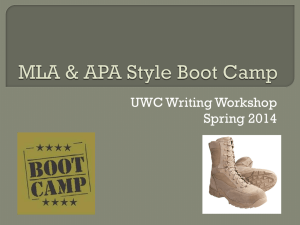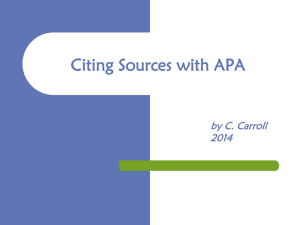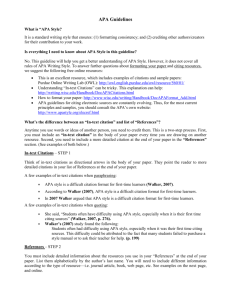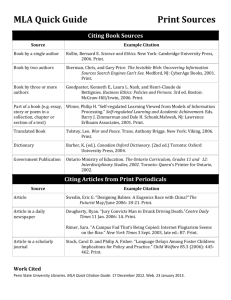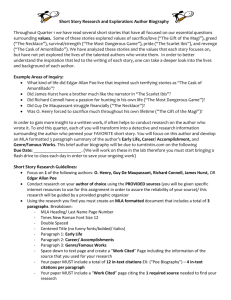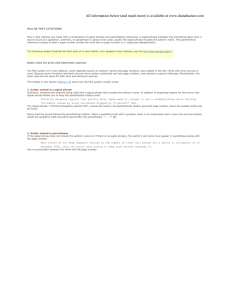Two-Steps - MiraCosta College
advertisement
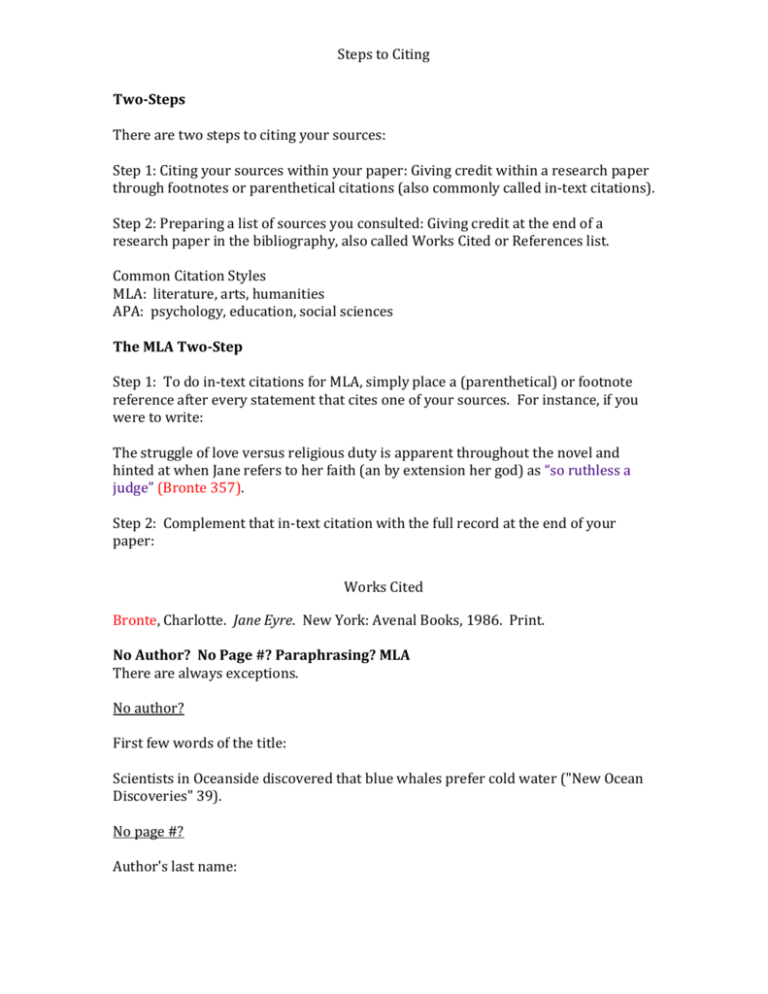
Steps to Citing Two-Steps There are two steps to citing your sources: Step 1: Citing your sources within your paper: Giving credit within a research paper through footnotes or parenthetical citations (also commonly called in-text citations). Step 2: Preparing a list of sources you consulted: Giving credit at the end of a research paper in the bibliography, also called Works Cited or References list. Common Citation Styles MLA: literature, arts, humanities APA: psychology, education, social sciences The MLA Two-Step Step 1: To do in-text citations for MLA, simply place a (parenthetical) or footnote reference after every statement that cites one of your sources. For instance, if you were to write: The struggle of love versus religious duty is apparent throughout the novel and hinted at when Jane refers to her faith (an by extension her god) as “so ruthless a judge” (Bronte 357). Step 2: Complement that in-text citation with the full record at the end of your paper: Works Cited Bronte, Charlotte. Jane Eyre. New York: Avenal Books, 1986. Print. No Author? No Page #? Paraphrasing? MLA There are always exceptions. No author? First few words of the title: Scientists in Oceanside discovered that blue whales prefer cold water ("New Ocean Discoveries" 39). No page #? Author's last name: Steps to Citing Blue whales also exhibit sonar capabilities like dolphins and use echolocation to find food (Gonzalez). The Process Steps to Citing Video Transcript: There are two steps involved in citing your sources: in text or parenthetical citations and a bibliography list that’s better known as Works Cited for MLA and Reference for APA. Since there are more than one citation style (MLA, APA, Chicago, etc…), we’ll just concentrate on the Modern Language Association or MLA. An in-text citation occurs when you provide credit to a source within your paper. In this example, a student took a direct quotation from a book and added it to her essay. She provides proper credit by citing the author and the page number where those words exist. This in-text citation gives partial credit to the overall source. Note that because the credit exists within the text, this first part of the citation process is known as “in-text” citing. Creating an in-text citation is relatively easy. You need the author’s name and page number enclosed in parenthesis. There are variations to this format since not all sources have an author or page number (especially web-based ones). Consult the MLA handbook for these variations or ask a librarian. It is important to keep in mind that in-text citations do not exist alone. In other words, you cannot just leave an in-text citation in your paper without referencing the complete bibliographic citation, which usually can be found at the end of the paper in the Works Cited or Reference page. The complete bibliographic citation provides the rest of the information for that intext source. Besides showing the author’s name, the complete citation displays the title of the work, the publisher, and the year of publication. Again, there are minor variation differences between the two main citations styles (MLA and APA), but for the most part, both styles include these basic features. Also, the complete bibliographic citation allows your readers the opportunity to find the source for their use. Some use it as a means to check your research. Lastly, providing this complete information helps you avoid plagiarism since you are properly giving credit to the source of information. If you need help, feel free to contact a librarian. Steps to Citing The APA Tango To do in-text citations for APA, simply place a (parenthetical) reference after every statement that cites one of your sources. For instance, if you were to write: The struggle of love versus religious duty is apparent throughout the novel and hinted at when Jane refers to her faith (an by extension her god) as “so ruthless a judge” (Bronte, 1986, p. 357). Complement that in-text citation with the full record at the end of your paper: References Bronte, C. (1986). Jane Eyre. New York, NY: Avenal Books. No Author? No Page #? Paraphrasing? APA There are always exceptions: No Author? No Page #? Direct Quote. Scientists in Oceanside discovered that "blue whales prefer colder water" and migrate according to the cold water jet stream ("New Ocean Discoveries," 2009). Paraphrasing? According to one researcher, students learn best when they are actively engaged (Gonzalez, 2012). [page number for a paraphrase is optional] APA Practice What info goes into the parenthetical or in-text citation? Jeremy Wang noted in his findings that community college students "are more successful when they take a research class at the beginning of their college career" ( _________ ). 2010, p.38 since the author's name is already mentioned in the sentence Wang, 2010, p.38 p. 38 Nothing needed.



